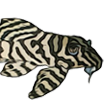I forgot this yeasterday, if you have an aquarium dedicated to only larger Panaque species and good filtration you could try to feed them old pieces of Alder (Alnus sp) that is a soft wood. They will consume it rapidly and it will disappear quite fast, I only recomend this for fanatics because in comunity tanks and aquarist's with not so much experience should not even try to use Alder.DP German wrote:But, if the fish are able to survive on wood alone it would be softer woods that would allow for this, and yet, this has not been observed.
I have never tried to only feed them soft wood so I have no idea if they would survive or grow in the long term.
Suckermouth wrote:Janne, what kinds of conditions do you think help promote Panaque growth? That's interesting that you say slow growth is a myth. My own sample size of one Panaque certainly isn't exactly good evidence to support that they're slow growing.
This is something that profesional breeders have known since decades, a good breeder change at least 50% up to 100% of the water every day in their growing tanks. Breeders that use high tecnology and have enough money build a filtration system you only can dream of but still change quite high amount of the water. Food VS water is the most important for breeders, that would be interesting to know what substances in the water that affects the growth... it can't only be nitroge'n products. For some years ago there was a discussion if keeping many fishes in a small water volume VS releasing pheromones affecting their growth, maybe also something that would be interesting for a study.Shane wrote:There have been some studies that show water quality to be more important than food availability w/ re to growth.
Than it can be something wrong with a fish making it grow slow, parasites or problem with their intestines or other problem.
Almost all drainage in the Amazon is very or extremely poor in minerals, Andean rivers is little more richer in minerals but still poor except a few exceptions.Shane wrote:Once again I think this may be both by sp and specific environment. Sand consumption makes a lot of sense from a nutrional stand point in very mineral poor waters like those originating in the Guyana Shield. This should be an easy one to test for actually.
Janne




